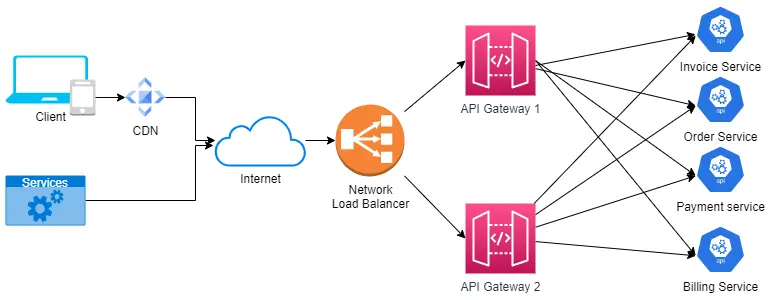In today’s interconnected digital landscape, businesses and developers rely heavily on Application Programming Interfaces (APIs) to enable communication and integration between different systems, services, and applications. However, managing APIs efficiently and securely can be a complex undertaking. This is where API gateways come into the picture.
Understanding API Gateways
An API gateway acts as a central point of entry for all incoming and outgoing API requests. It provides a unified interface, abstracting away the complexities of managing multiple APIs and allowing developers to focus on building applications rather than dealing with integration intricacies. API gateways typically offer a range of features, including request routing, authentication, authorization, rate limiting, caching, logging, and monitoring.
Sometimes it is mis-understood that API gateways only take care integration between client and the API service but in reality, API gateway manages any traffic from any consumer to the API service, be it from client or any another service.
API gateways vs Load Balancer
While API gateways and load balancers share some similarities (Load balancing, request routing), they serve distinct purposes and have different scopes of functionality.
While both API gateways and load balancers (Application) can handle traffic routing, API gateways offer a broader range of functionalities focused on API management, security, and developer experience. API gateways are specifically designed to manage APIs comprehensively, whereas load balancers excel at optimizing resource utilization and ensuring high availability.
Load balancers (Network) typically operate at the network or transport layer (Layer 4) of the OSI model. They distribute traffic across servers or backend instances based on protocols like TCP or UDP, focusing on load distribution and health monitoring.
API gateways operate at a higher level, typically at the application layer (Layer 7) of the OSI Model.
In some cases, organizations may choose to utilize both an API gateway and a load balancer in combination to leverage their respective strengths.
Nice to read Load Balancer: Gateway to application reliability
What is the best market available API gateway?
There are several market-available options for API gateways, offering various features and deployment options. Some popular API gateway solutions include:
Amazon API Gateway: Amazon API Gateway is a fully managed service provided by Amazon Web Services (AWS). It offers features like request/response transformations, security with AWS Identity and Access Management (IAM), caching, rate limiting, and integration with other AWS services. It can be easily integrated with AWS Lambda for serverless API deployments.

Azure API Management: Azure API Management is a comprehensive API management solution offered by Microsoft Azure. It provides functionalities such as API gateway, developer portal, analytics, security, and monetization options. It supports features like caching, rate limiting, authentication, and transformation policies. Azure API Management can be used with serverless Azure Functions or other backend services.
Google Cloud Endpoints: Google Cloud Endpoints is a fully managed API gateway solution provided by Google Cloud Platform. It offers features like authentication, monitoring, logging, rate limiting, and request/response transformations. Cloud Endpoints can be used with serverless options like Google Cloud Functions or Google App Engine, as well as with traditional backend services.
Kong: Kong is an open-source API gateway and service mesh platform that provides a range of features for managing APIs, including routing, load balancing, authentication, rate limiting, and plugin support for extending functionality. Kong can be deployed in various configurations, including as a self-hosted solution or as a managed service through Kong Cloud.
Tyk: Tyk is an open-source API gateway that offers features like authentication, rate limiting, analytics, transformations, and access control policies. It supports deployment options such as self-hosted, cloud-based, and hybrid setups. Tyk also provides an API portal for developer self-service.
API gateways can also be utilized in serverless architectures. For example, Amazon API Gateway integrates seamlessly with AWS Lambda, allowing you to create serverless APIs. Azure API Management can be used in conjunction with Azure Functions, and Google Cloud Endpoints can be utilized with serverless services like Google Cloud Functions. These combinations provide a serverless approach to API development and deployment, where the backend processing is handled by serverless functions while the API gateway handles the request/response flow and management aspects.
The choice of best suitable API gateway ultimately depends on specific requirements, preferences, and compatibility with your existing infrastructure.
Key Benefits
Simplifying API Management: One of the primary advantages of using an API gateway is simplified API management. Instead of directly integrating with various APIs, developers can interact with a single API gateway, reducing the complexity and enabling better control and visibility. The gateway acts as an intermediary, handling all the necessary tasks related to API interactions, such as request transformation, protocol translation, and error handling. This abstraction layer enhances the efficiency of the development process.
Enhancing Security: API gateways play a crucial role in ensuring the security of API-based architectures. By centralizing security measures, such as authentication and authorization, the gateway acts as a protective shield, safeguarding APIs and the underlying infrastructure. With a well-configured API gateway, developers can enforce access controls, implement OAuth or API key-based authentication, and apply fine-grained authorization policies. Additionally, a gateway can provide an extra layer of security through measures like rate limiting and IP whitelisting, mitigating the risk of malicious activities or unexpected traffic spikes.
Enabling Scalability and Performance: API gateways excel at managing scalability and optimizing performance. By implementing caching mechanisms, gateways can store frequently accessed responses, reducing the load on backend services and improving response times. They also allow for request and response transformations, enabling developers to modify payloads or filter data to fit specific requirements. Furthermore, with built-in rate limiting and throttling capabilities, gateways can prevent API abuse and control traffic flow, ensuring optimal performance and stability.
Simplifying Cross-cutting Concerns: In a microservices or distributed architecture, numerous cross-cutting concerns, such as logging, monitoring, and analytics, need to be addressed across all APIs. API gateways provide a centralized location to handle these concerns, making it easier to implement standardized logging, capture metrics, and perform health checks. This unified approach saves development time, promotes consistency, and simplifies the monitoring and debugging processes.
Takeaway 💡
In the Fig1 traffic from Client to API gateway routed though CDN. Why do we need CDN?




